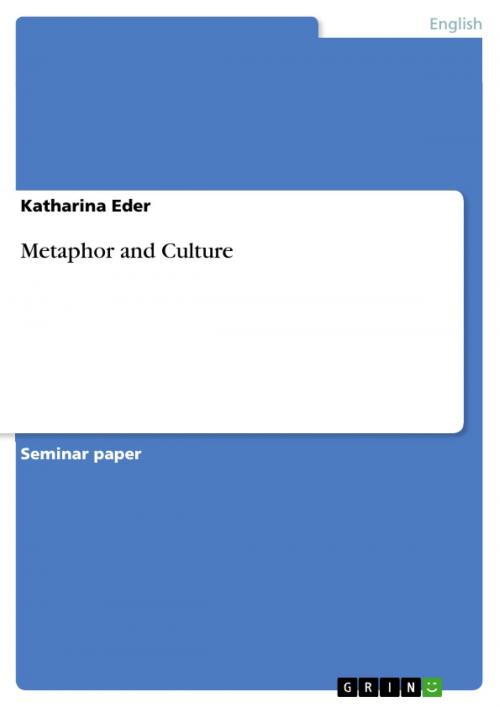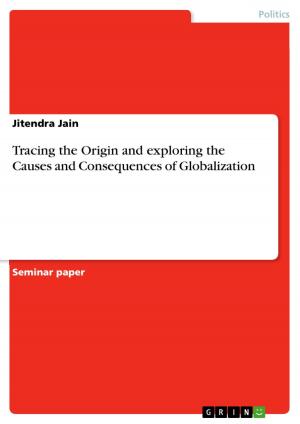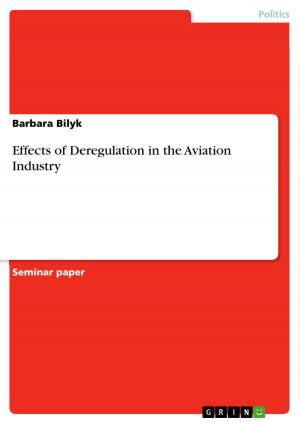| Author: | Katharina Eder | ISBN: | 9783640606528 |
| Publisher: | GRIN Publishing | Publication: | April 27, 2010 |
| Imprint: | GRIN Publishing | Language: | English |
| Author: | Katharina Eder |
| ISBN: | 9783640606528 |
| Publisher: | GRIN Publishing |
| Publication: | April 27, 2010 |
| Imprint: | GRIN Publishing |
| Language: | English |
Seminar paper from the year 2009 in the subject English Language and Literature Studies - Linguistics, grade: 1, University of Vienna (Anglistik), language: English, abstract: The main questions that arise given this way of thinking about the connection between metaphor and culture are on the one hand 'To what extent do people share their metaphors?', which at first seemingly trivial becomes much more significant and interesting if we ourselves 'To what extent do people around the world share their understandings of images and aspects of the world they live in?'. These questions are of particular interest to me, and were decisive for me regarding the selection of the topic of this paper. In fact, the field of 'Metaphor and Culture' comprises many subtopics, such as for instance 'Universality in Metaphorical Conceptualization', 'Cross-Cultural and Within-Cultural Variation in Metaphor', 'Conceptual Metaphors and Their Linguistic Expression in Different Languages', 'Metaphor and Cultural Models', or 'The Causes of Metaphor Variation'. Since I did not want to be too general in this paper, and also wanted to give insight into some practical aspects of the topic, I decided to concentrate on a two specific 'subtopics', and deal with them in greater detail. In the first part, the paper will shed light on a study by Talebinejad & Dastjerdi´s (2005), who chose animal metaphors for the comparison in two typologically different languages, namely English and Persian. The second part of this paper will address the 'Causes of Variation in Metaphor', whereas the focus lies exclusively on the field of 'Differential Experience'.
Seminar paper from the year 2009 in the subject English Language and Literature Studies - Linguistics, grade: 1, University of Vienna (Anglistik), language: English, abstract: The main questions that arise given this way of thinking about the connection between metaphor and culture are on the one hand 'To what extent do people share their metaphors?', which at first seemingly trivial becomes much more significant and interesting if we ourselves 'To what extent do people around the world share their understandings of images and aspects of the world they live in?'. These questions are of particular interest to me, and were decisive for me regarding the selection of the topic of this paper. In fact, the field of 'Metaphor and Culture' comprises many subtopics, such as for instance 'Universality in Metaphorical Conceptualization', 'Cross-Cultural and Within-Cultural Variation in Metaphor', 'Conceptual Metaphors and Their Linguistic Expression in Different Languages', 'Metaphor and Cultural Models', or 'The Causes of Metaphor Variation'. Since I did not want to be too general in this paper, and also wanted to give insight into some practical aspects of the topic, I decided to concentrate on a two specific 'subtopics', and deal with them in greater detail. In the first part, the paper will shed light on a study by Talebinejad & Dastjerdi´s (2005), who chose animal metaphors for the comparison in two typologically different languages, namely English and Persian. The second part of this paper will address the 'Causes of Variation in Metaphor', whereas the focus lies exclusively on the field of 'Differential Experience'.















